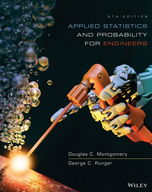Solution Found!
The rate of return of an asset is the change in price
Chapter 5, Problem 78E(choose chapter or problem)
The rate of return of an asset is the change in price divided by the initial price (denoted as r). Suppose that $10,000 is used to purchase shares in three stocks with rates of returns \(X_{1}, X_{2}, X_{3}\). Initially, $2500, $3000, and $4500 are allocated to each one, respectively. After one year, the distribution of the rate of return for each is normally distributed with the following parameters:
\(\mu_{1}=0.12, \sigma_{1}=0.14, \mu_{2}=0.04, \sigma_{2}=0.02, \mu_{3}=0.07, \sigma_{3}=0.08\)
(a) Assume that these rates of return are independent. Determine the mean and variance of the rate of return after one year for the entire investment of $10,000.
(b) Assume that \(X_{1}\) is independent of \(X_{2}\) and \(X_{3}\) but that the covariance between \(X_{2}\) and \(X_{3}\) is ?0.005 Repeat part (a).
(c) Compare the means and variances obtained in parts (a) and (b) and comment on any benefits from negative covariances between the assets.
Questions & Answers
QUESTION:
The rate of return of an asset is the change in price divided by the initial price (denoted as r). Suppose that $10,000 is used to purchase shares in three stocks with rates of returns \(X_{1}, X_{2}, X_{3}\). Initially, $2500, $3000, and $4500 are allocated to each one, respectively. After one year, the distribution of the rate of return for each is normally distributed with the following parameters:
\(\mu_{1}=0.12, \sigma_{1}=0.14, \mu_{2}=0.04, \sigma_{2}=0.02, \mu_{3}=0.07, \sigma_{3}=0.08\)
(a) Assume that these rates of return are independent. Determine the mean and variance of the rate of return after one year for the entire investment of $10,000.
(b) Assume that \(X_{1}\) is independent of \(X_{2}\) and \(X_{3}\) but that the covariance between \(X_{2}\) and \(X_{3}\) is ?0.005 Repeat part (a).
(c) Compare the means and variances obtained in parts (a) and (b) and comment on any benefits from negative covariances between the assets.
Step 1 of 4
Let \(X_{1}, X_{2}, X_{3}\) are the rates of returns of three stocks
Here all are following the normal distribution
Then,
\(\begin{aligned} X_{1} & \sim N\left(0.12,(0.14)^{2}\right) \\ X_{2} & \sim N\left(0.04,(0.02)^{2}\right) \\ X_{3} & \sim N\left(0.07,(0.08)^{2}\right) \end{aligned}\)
Let \(Y\) be the total rate of return after one year
Then \(Y=X_{1}+X_{2}+X_{3}\)
